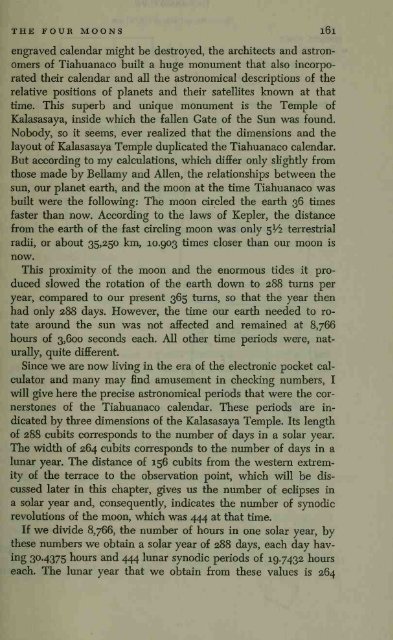Create successful ePaper yourself
Turn your PDF publications into a flip-book with our unique Google optimized e-Paper software.
THE FOUR MOONS<br />
l6l<br />
engraved calendar might be destroyed, the architects and astronomers<br />
of Tiahuanaco built a huge monument that also incorporated<br />
their calendar and all the astronomical descriptions of the<br />
relative positions of planets and their satellites known at that<br />
time. This superb and unique monument is the Temple of<br />
Kalasasaya, inside which the fallen Gate of the Sun was found.<br />
Nobody, so it seems, ever realized that the dimensions and the<br />
layout of Kalasasaya Temple dupKcated the Tiahuanaco calendar.<br />
But according to my calculations, which differ only slightly from<br />
those made by Bellamy and Allen, the relationships between the<br />
sun, our planet earth, and the moon at the time Tiahuanaco was<br />
built were the follovmig: The moon circled the earth 36 times<br />
faster than now. According to the laws of Kepler, the distance<br />
from the earth of the fast circling moon was only 5 1/2<br />
radii,<br />
now.<br />
terrestrial<br />
or about 35,250 km, 10.903 times closer than our moon is<br />
This proximity of the moon and the enormous tides it produced<br />
slowed the rotation of the earth down to 288 turns per<br />
year, compared to our present 365 turns, so that the year then<br />
had only 288 days. However, the time our earth needed to rotate<br />
around the sun was not affected and remained at 8,766<br />
hours of 3,600 seconds each. All other time periods were,<br />
naturally,<br />
quite different.<br />
Since we are now living in the era of the electronic pocket calculator<br />
and many may find amusement in checking numbers, I<br />
will give here the precise astronomical periods that were the cornerstones<br />
of the Tiahuanaco calendar. These periods are indicated<br />
by three dimensions of the Kalasasaya Temple. Its length<br />
of 288 cubits corresponds to the number of days in a solar year.<br />
The width of 264 cubits corresponds to the number of days in a<br />
lunar year. The distance of 156 cubits from the western extremity<br />
of the terrace to the observation point, which will be discussed<br />
later in this chapter, gives us the number of eclipses in<br />
a solar year and, consequently, indicates the nimaber of synodic<br />
revolutions of the moon, which was 444 at that time.<br />
If we divide 8,766, the number of hours in one solar year, by<br />
these numbers we obtain a solar year of 288 days, each day having<br />
30.4375 hours and 444 lunar synodic periods of 19.7432 hours<br />
each. The lunar year that we obtain from these values is 264

















